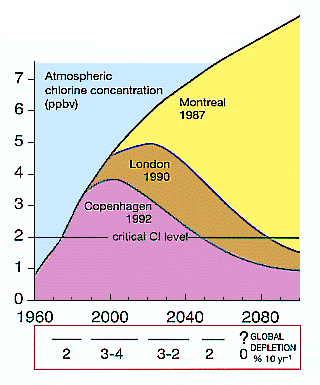THE FUTURE
As can be seen, WMO has played a major role in identifying and communicating the problem of ozone depletion. It has coordinated assessments of the authoritative scientific evidence to support the UNEP- led international discussions which led to the Vienna Convention, its Montreal Protocol and subsequent amendments. Even with full international compliance with the existing agreements, it is estimated that chlorine and bromine concentrations will continue to increase in the stratosphere until the turn of the century. Peak global ozone losses are expected to occur during the next ten years, when another 3-4% of the ozone will be destroyed (in some years more), before the rates of decline ozone level off and start to diminish (see last line of Figure 20).

|
Figure 20 -- The measured chlorine-equivalent concentrations in the atmosphere (since 1960) and projections according to the various measures to phase out CFCs and other ozone-depleting substances. The numbers on the bottom line indicate the predicted global ozone depletion per decade if the conditions of the strengthened Montreal Protocol are observed |
It is very difficult to predict with any certainty when the ozone layer might recover. Figure 20 shows the calculated stratospheric chlorine- equivalent concentrations resulting from the predicted manufacture and consumption levels of halocarbons with full compliance to the original Protocol. its London amendment and the more stringent measures for phase out by January 1996 as accepted at the Copenhagen Conference (November 1992). Scientific evidence points to the stratospheric chlorine- equivalent concentration of 2 parts per billion volume (ppbv), reached at the end of the 1970s, as being a dangerous threshold for ozone depletion.
At the present time, chlorine-equivalent concentrations exceed 3.7 ppbv, and are expected to increase for another 3-5 years. Without the Montreal Protocol, continuing use of CFCs and other ozone destructive compounds would have tripled the present stratospheric abundance of chlorine and bromine by the middle of the next century. Such increases would have led to ozone depletion very much larger than that observed today.
Only full compliance with the Montreal Protocol, strengthened by the London and Copenhagen amendments, will prevent chlorine levels exceeding 4 ppbv and ensure that they begin to decline to reach the 2 ppbv level some time in the middle of the next century. All things being equal. only then would the ozone layer return to normal pre-ozone-hole levels. It should be emphasized that the expected recovery of the ozone layer would have been impossible without the Montreal Protocol and its amendments.
Decision-makers must have authoritative information on the state of the ozone layer when they review existing international agreements. To provide this information, the GO3OS must be maintained and improved well into the next century. As must the entire Global Atmosphere Watch (GAW) that monitors other chemical constituents of the atmosphere, from both ground and space. Only the common efforts of national Meteorological Services and environmental authorities, encouraged and coordinated by WMO and UNEP, can provide scientists with the necessary data. Then they can make more accurate assessments and predictions needed by governments to protect the global environment for future generations.
As UNEP is called upon to coordinate environmental protection treaties, so WMO is being called upon to meet increasing obligations regarding the monitoring and study of ozone and other atmospheric pollutants. To meet these challenges, WMO and UNEP will have to collaborate even more closely with one another and with their Members and other international and national institutions. Through such collaboration it will be possible for WMO and UNEP to fulfil their responsibilities and provide the basis for concentrated international action to safeguard the atmosphere. By assessing and predicting the extent of harmful human influences, they will be able to issue warnings of danger. As mentioned in the Foreword, a spirit of cooperation among scientists, governments and industry has been evident in negotiations to protect the ozone layer. On the occasion of its 50th Anniversary, and in the decades to follow, the United Nations can be proud of this achievement which will help ensure a prosperous and sustainable planet for the peoples of the world.
|
CHLORINE EQUIVALENTS Ozone recovery will depend on how fast stratospheric concentrations of both chlorine and bromine decline. Scientists have calculated those concentrations into equivalent stratospheric chlorine loading values to provide an estimate for future ozone depletion. |
|
METHYL BROMIDE Another widely-used chemical which poses a threat to the ozone layer is methyl bromide CH3Br. This can release bromine, which is 30 to 60 times as destructive to ozone as is chlorine. Methyl Bromide is used as a fumigant for soils and commodities, including the quarantine treatment of some products for international trade, and as a transport fuel additive. Total annual anthropogenic release is now estimated to be more than double the 40 000 tonnes released annually in the early 1980s. In addition, natural sources such as burning biomass contribute a further 30 000 to 50 000 tonnes a year. More than half of all the CH3Br produced is released into the atmosphere, where concentrations are currently between 8 and 15 parts per thousand. million by volume. No single alternative chemical is at present available to replace all methyl bromide applications. |